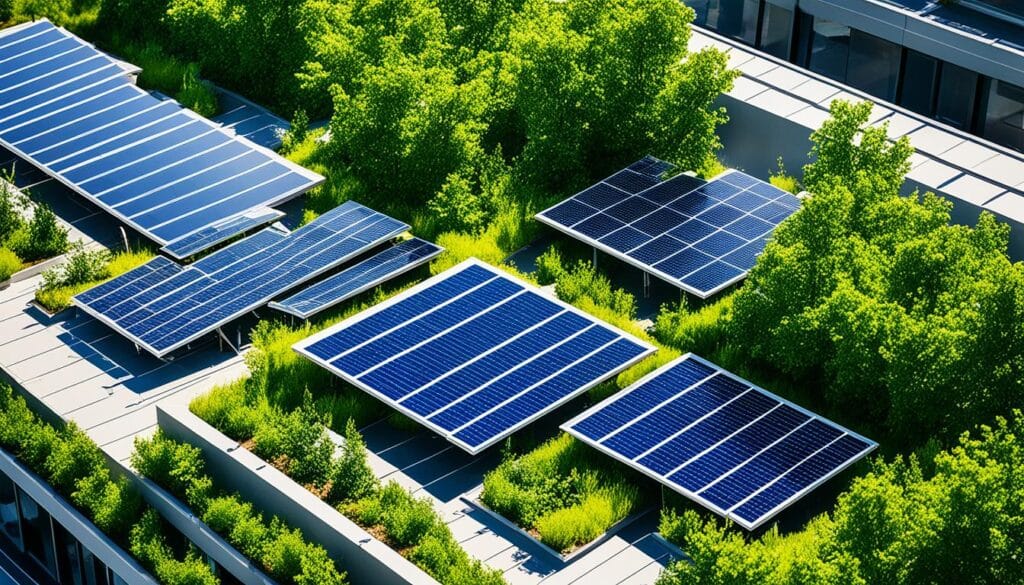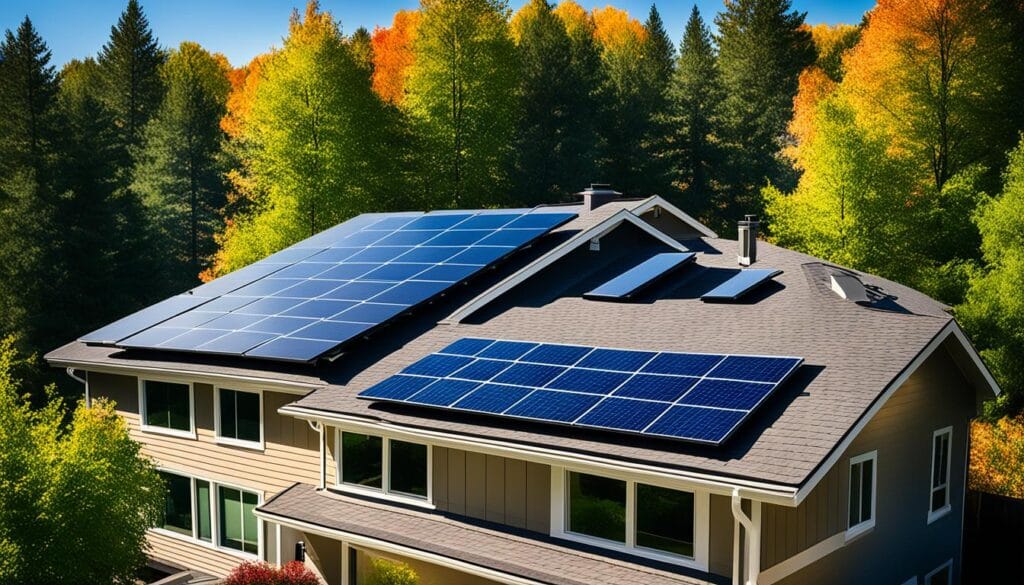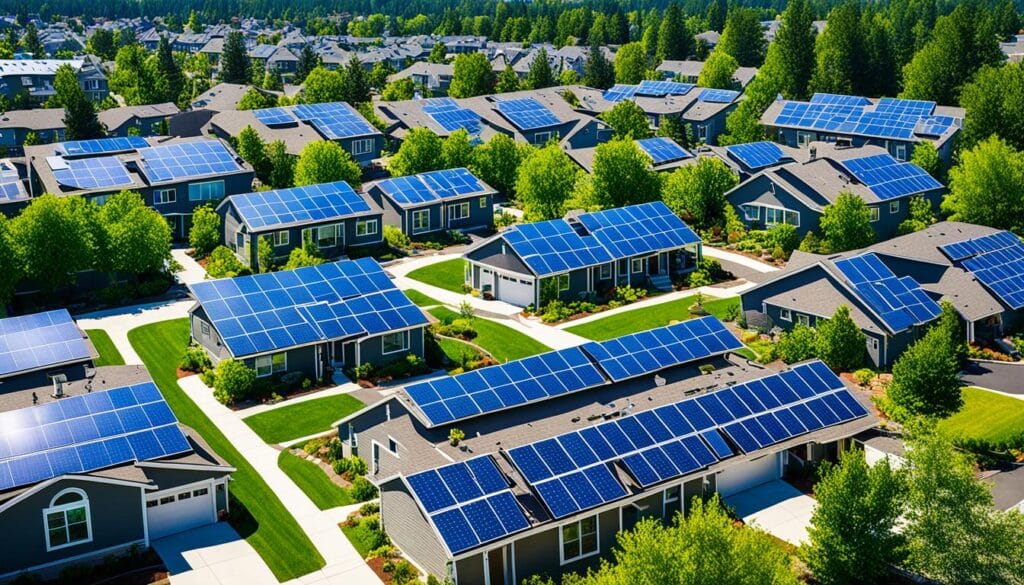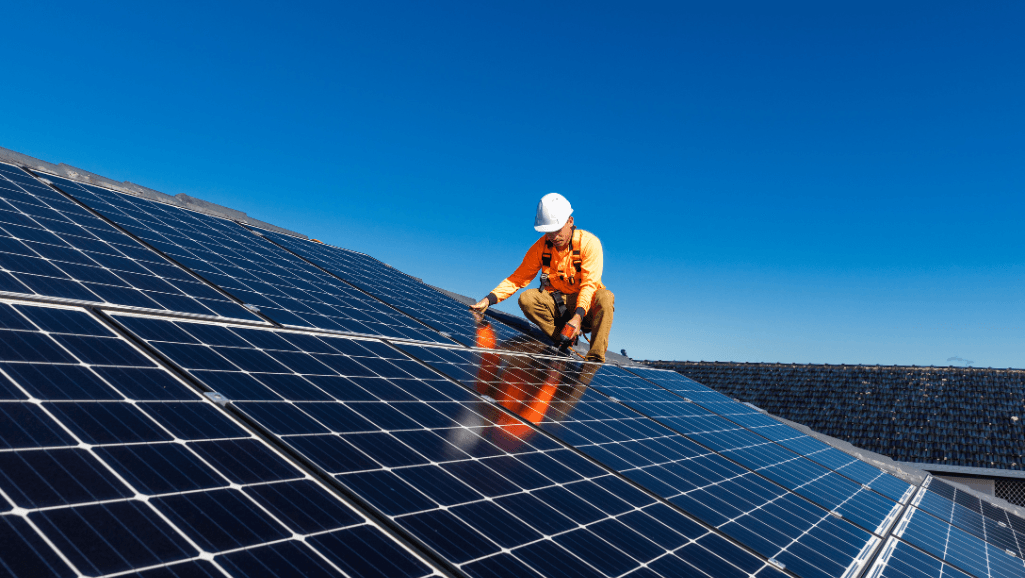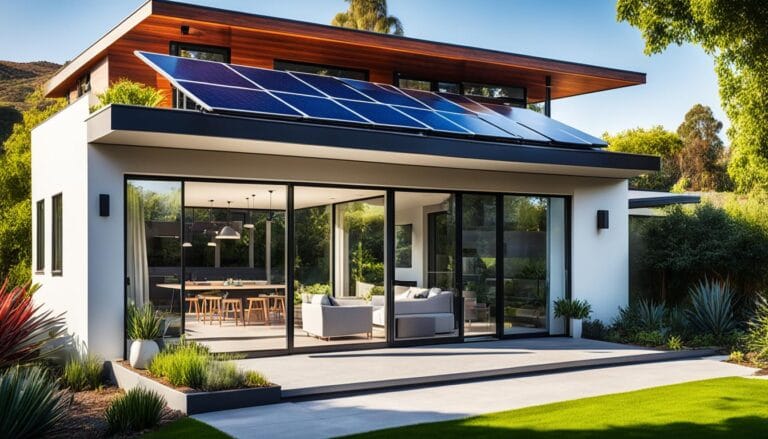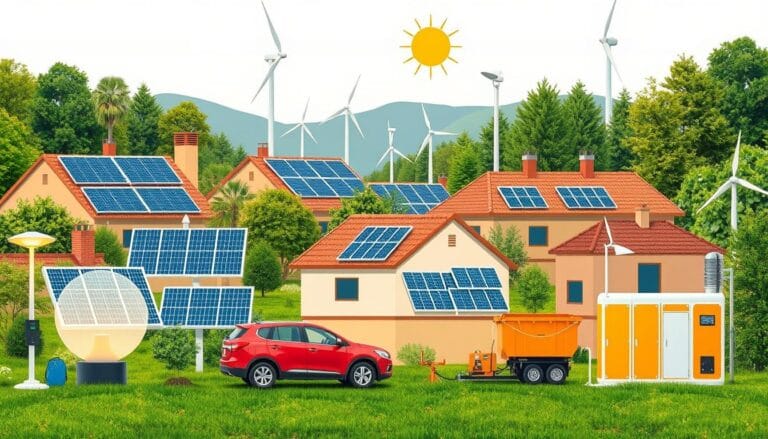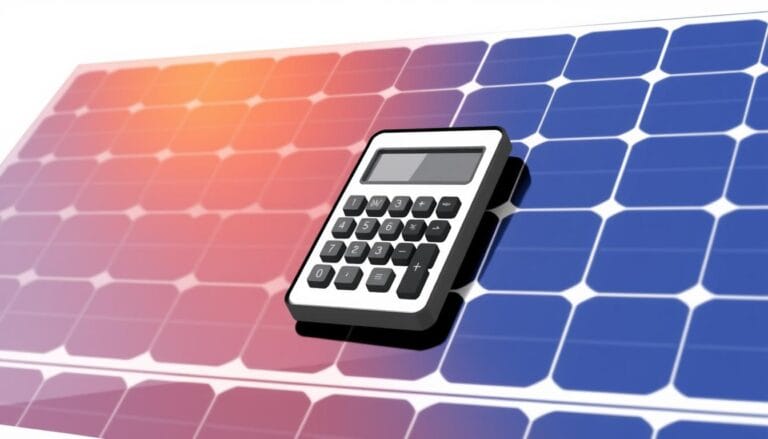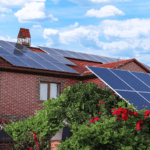Nearly 4 million American homes are now embracing sustainable energy solutions with affordable solar technology. This shift is not just about saving money on energy bills. It’s also a step towards using environmentally friendly power. Solar technology is becoming a smart choice for homeowners, offering quick payback on energy costs.
Choosing affordable clean energy is more appealing than ever. Adding solar energy to a home can increase its value by about $15,000. It also meets the desire for a renewable energy source that promotes independence. Solar panels work well in many places, proving that solar power is possible everywhere thanks to new technology.
Key Takeaways
- Economic incentives, including a significant tax credit, make solar a smart financial decision.
- The integration of solar systems can potentially nullify electricity bills for decades.
- Emerging community solar projects democratize accessibility to renewable energy.
- Advancements in technology and strategic partnerships have streamlined solar installation.
- With consistent cost reductions, solar energy is an increasingly attainable investment.
- Solar power capacity is enough to cover the energy needs of an average American home.
The Financial and Environmental Benefits of Solar Energy
Using solar technology boosts energy independence and supports eco-friendly upgrades. It’s a wise choice that offers big financial gains and helps cut down on harmful emissions.
Substantial Reduction in Utility Bills
Switching to solar energy can greatly lower your utility bills. The average U.S. household uses about 10,632 kilowatt-hours (kWh) of electricity yearly. Solar power can cut or even wipe out these costs, saving you money over time. This means more cash in your pocket and a step towards energy freedom.
Enhancement of Property Value with Solar Installations
Solar systems also boost your home’s value. Homes with solar panels often sell for more. For every dollar saved on energy bills, your home’s value could go up by $20. This shows the big benefits of going solar, making your home more attractive and valuable.
Impressive Environmental Impact Reductions
Switching to solar energy is great for the planet too. It’s like planting 125 trees every year or avoiding the burning of thousands of pounds of coal. Learn more about how solar energy saves natural resources and cuts down on pollution. It reduces harmful pollutants that can cause serious health issues, making communities healthier.
The financial perks of solar energy, along with its environmental benefits, make it a top choice for modern homes. It lessens our reliance on non-renewable energy, raises property values, and offers access to solar incentives. Homeowners enjoy a cleaner, more affordable living space.
Affordable Solar Technology: A Path to Cost-Effective Power
The world of affordable solar energy products has changed a lot in the last 20 years. Costs for both starting and running have gone down a lot. Thanks to better economical solar panels and inexpensive solar technology, people are saving a lot of money. They also get a good return on their investment in renewable energy.
| Year | Cost per Watt | Total System Cost (for 50kW) |
|---|---|---|
| 2000 | $11 | $550,000 |
| 2010 | $6 | $300,000 |
| 2020 | $1.70 | $84,000 |
The move to cost-effective solar power is clear from the falling prices and new technology. For example, SunPower® makes some of the best panels around. They make more electricity per square foot, making clean power solutions more practical.
- Technology has cut solar system costs by about 80% from 2000 to 2020.
- Better solar cells mean more electricity and lower costs over time.
- New materials like metal-halide perovskites absorb UV light well, pushing efficiency limits.
Embracing low-cost solar solutions like tandem solar photovoltaic cells shows how fast this field is changing. These cells can work up to 46% efficiently. This innovative solar technology is a smart money move and a step towards a greener future.
The path to a sustainable future is powered by ongoing innovation and lower costs in solar tech. As prices keep falling, more people will likely turn to affordable solar energy products. This will be key in the global move towards clean power solutions.
Understanding the Cost Savings from Solar Power Systems
Choosing solar power is a big step for both the planet and your wallet. It can lead to big savings over time. If you’re looking at affordable solar systems for your home or business, knowing the savings and how to get the most from your investment is key.
Calculating Your Potential Solar Savings
Figuring out how much you can save with solar involves looking at your energy use, the size of the system you need, local energy prices, and tax credits for renewable energy. For instance, if you pay $150 a month for electricity, solar could cut your costs significantly over the system’s life. Solar panels also make your home more energy-efficient.
Switching to solar can lead to huge savings, especially since hardware costs are dropping. Making the installation process smoother and cutting down on bureaucratic delays can boost these savings even more. Plus, community solar projects let you enjoy solar benefits without the high upfront cost.
How Solar Investment Translates into Long-Term Benefits
Going solar is more than just lowering your energy bills. Solar panels last 20-30 years and you can claim up to 30% of the setup costs through tax credits. This means the financial gains are both quick and lasting.
Recently, the tax credit for solar installations jumped to 30%, covering labor and equipment costs. There are also loans and financing options available, making solar more reachable and affordable.
Understanding the financial benefits of solar energy is crucial. Switching to renewable energy helps the environment and brings big economic gains. With tax incentives and a strong return on investment, it’s a smart choice for both homes and businesses.
Advancements in Economical Solar Panels for Home Use
The search for better and cheaper renewable energy has led to big steps in solar tech. Now, getting into affordable renewable energy options is easier for homeowners wanting home solar systems.
Technological Innovations Lowering Solar Costs
Recent years have seen big changes in solar technology, especially in materials and making them. Thin-film solar cells are lighter and cheaper, making low-cost solar panel installations possible. Perovskite solar cells are also changing the game with their lower costs and simpler making.
Solar tracking tech helps catch more sunlight, possibly upping energy by up to 25%. Advanced tech also brings us bifacial solar panels. These panels catch sunlight from both sides, greatly increasing energy output.
Accessibility of Solar Systems for Residential Properties
More people are using residential solar energy solutions thanks to cheaper and more efficient solar panels. New panels from an Oxford firm hit near 28% efficiency, setting new highs. Building-integrated photovoltaics (BIPV) are also on the rise, expected to hit $86.7 billion by 2030.
Today’s panels lose only about 0.3% efficiency each year. This means they can still work well over 25 years, making accessible solar options a smart choice. These technologies could make homes energy-independent, like solar panels on farms that help crops grow and save water.
As solar tech keeps getting better, with things like multi-junction cells and storage, a solar-powered future seems closer. These advancements in solar technology make solar energy a wise, affordable renewable energy option for more homeowners worldwide.
How Solar Energy Works and Its Nationwide Accessibility
Learning about how solar energy works starts with understanding photovoltaics. Solar panels turn sunlight into electricity, giving us a clean, renewable energy source. In the U.S., solar energy is accessible almost everywhere, thanks to its vast potential.
The U.S. now has 137.5 gigawatts of solar energy capacity, growing by about 25% each year. Solar power is used on homes and in big projects, showing how it fits into many places and buildings.
Solar energy is not just common; it’s also flexible. It helps people who don’t own homes get solar power. Solar-plus-storage systems give energy independence by combining panels with batteries. Solar energy is used for heating, cooling, and making electricity, depending on the system.
With more capacity coming and costs going down, ubiquitous solar solutions will change how we power our places. New solar cells, like perovskite, could be up to 33% efficient, which is a big step forward.
The solar industry is growing fast, which is good for the environment and the economy. Over a million Americans might work in solar by 2030, bringing in over $120 billion a year. This shows how important solar is for our energy future.
In short, solar power everywhere makes us more independent, supports green growth, and creates jobs across the U.S. As solar tech gets better, it reaches more people, making solar energy a key part of our lives.
The Role of Government Incentives in Solar Adoption
Government solar incentives show a strong support for renewable energy and solar adoption. They offer various incentives, like federal solar tax credits and state-level incentives. These help lower the cost and speed up the adoption by homeowners and businesses.
Federal solar tax credits are a big help in promoting solar investments. They let you deduct up to 26% of the system cost from your federal taxes. This makes solar more affordable and boosts savings.
Maximizing Savings with Federal Solar Tax Credits
These tax credits have played a key role in increasing U.S. solar installations. They make solar more affordable and are a strong reason for people and companies to invest in clean energy.
Understanding State-Level Incentives and Rebates
States also offer solar incentives to encourage eco-friendly investments. Many states have tax rebates and property tax exemptions that lower the cost of solar installations. Net metering policies give credits for adding electricity back to the grid.
States like California and New York offer big solar rebates and incentives. This helps more people and businesses go solar. These programs support a shift to renewable energy for a sustainable future.
These efforts at different government levels show in the growing number of solar power installations. They are key for the environment, economy, and energy independence.
Through rebates, tax credits, and subsidies, the government makes solar energy more accessible. These actions are vital for our planet’s future. They drive innovation and eco-friendly energy solutions.
Long-Term Financial Planning with Solar Energy Solutions
Going solar is a smart move for your wallet and the planet. It’s a way to save money and protect against rising energy costs. By choosing solar, you can enjoy big savings and a good return on your investment.
Protecting Against Rising Energy Costs
Getting ready for higher energy prices is key to smart money planning. Solar power systems have fixed costs, so you won’t feel the sting of price hikes. This makes your energy bills more predictable, helping you keep your finances stable.
Calculating the Return on Investment for Solar Panels
Understanding the value of solar panels means looking at their costs and savings. You need to think about the upfront expenses, the system’s lifespan, and how much you’ll save on energy. This helps you see how solar can save you money over time.
| Year | Estimated Solar Power Generation (kWh) | Projected Energy Cost Savings ($) | Cumulative Financial Benefits ($) |
|---|---|---|---|
| 1 | 1,200 | 300 | 300 |
| 5 | 6,000 | 1,800 | 2,700 |
| 10 | 12,000 | 4,200 | 8,100 |
| 20 | 24,000 | 10,800 | 25,200 |
This table shows how solar energy can pay off over time. With inflation and rising energy costs, solar can lead to big savings. There are many ways to get solar, like loans, leases, and PPAs, making it easier for everyone to go solar.
Adding solar to your financial plan can bring great rewards. It helps protect you from energy price jumps and supports the environment. It’s a smart choice for your wallet and the planet.
Solar Power as a Sustainable Lifestyle Choice
Choosing solar power is more than just a way to save energy. It shows you care about the planet and want to live sustainably. This growing way to get clean energy helps us use less oil and gas. It also cuts down on harmful emissions, showing we’re serious about protecting our environment and using energy wisely.
When people and communities go solar, they start a big change. They show that using renewable energy is better than the old ways. Solar power has a big effect on communities, helping with the economy, the planet, and people’s lives. By using solar, homes and businesses lead the way in being green. They encourage others to live more sustainably.
Environmental Stewardship through Clean Energy
Solar energy is leading the way in clean energy. Switching to solar has greatly reduced harmful emissions. Solar is the cleanest energy source, helping fight climate change and keeping our environment healthy. It uses the sun’s power without harming the earth, showing true care for our planet.
Community Impact and Setting an Eco-Friendly Example
More solar power means better sustainability and stronger communities. It helps local economies by creating jobs in solar tech. Plus, solar energy makes buildings and homes more valuable and saves money, showing how to live green. These actions make a big difference in communities, moving us towards a sustainable future.
Conclusion
The rise of affordable solar investments has made embracing solar technology a key goal for a better future. The cost of solar PV systems in the U.S. has fallen a lot. This shows we’re moving towards eco-friendly energy solutions, thanks to the Solar Investment Tax Credit and other incentives.
Looking ahead to 2030, solar power is expected to make up 20% of U.S. energy use. This shows we’re in the middle of a big change to sustainable energy. Costs have dropped from ₹11 per watt to just ₹1.70. Companies like Affordable Solar have installed over 2,500 solar arrays with strong warranties and expert installations.
Advances in solar tech have made it even better, with efficiency going from 15% to over 20%. This means solar power is becoming a key energy source. Chariot Energy’s growth in solar installations shows we’re really getting into the renewable energy revolution.
As we learn more about solar technology, we’re writing our own ultimate guide to solar. This story shows us how solar energy is smart for our wallets and the planet. By choosing solar, we’re helping create a world that values both money and the environment.



